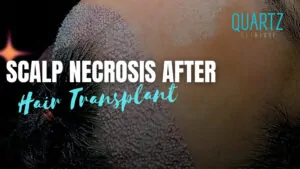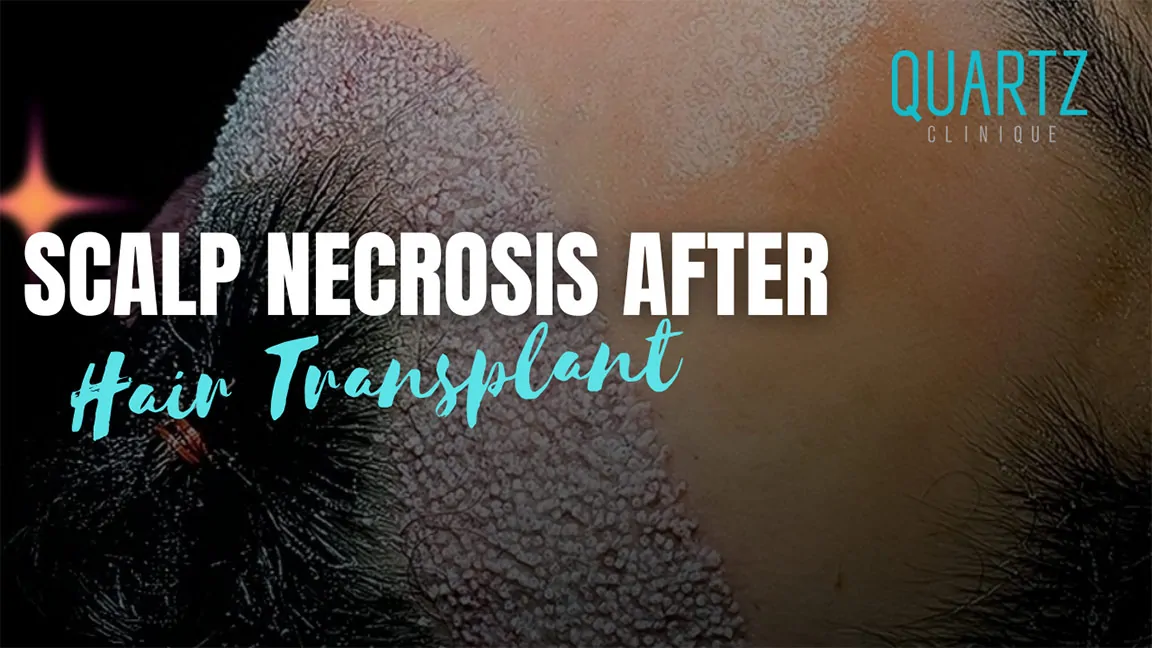 Scalp Necrosis After Hair Transplant: Every surgery has its risks and side effects. One rare but serious complication that can occur after a hair transplant surgery is scalp necrosis. It is important to be aware of the symptoms of scalp necrosis as early intervention can help minimize the affected area and mitigate further damage to the surgical results.
Scalp Necrosis After Hair Transplant: Every surgery has its risks and side effects. One rare but serious complication that can occur after a hair transplant surgery is scalp necrosis. It is important to be aware of the symptoms of scalp necrosis as early intervention can help minimize the affected area and mitigate further damage to the surgical results.
For a timely intervention, knowledge of the situation’s causes and how to comprehend them will be helpful. Although hair transplantation may appear to be a straightforward surgical procedure, it actually has a very complicated and complex structure. Following the procedure, there could be some complications. In this post, we’ll dive into the details of scalp necrosis, what causes it, and how to treat it, so read on to find out everything you need to know about it.
What Is Necrosis?
Necrosis is the permanent destruction of tissue. Unlike necrobiosis, it is not genetically predetermined and instead happens prematurely and by accident. It may happen for a variety of reasons. Frostbite is one kind of necrosis that many people are familiar with. Blood vessels tighten, the water in the skin freezes, and the blood and oxygen supply to the body’s cells are cut off. The tissue cells stop functioning as a result of this.
The cell first swells, and then it bursts, letting its contents spill out into the tissue around it. The body then reacts by going into inflammatory mode. An autoimmune disorder can also cause this. Sadly, necrosis cannot be reversed, so the surgeon must remove the skin. Necrotic tissue will have a black, leathery, and possibly loose appearance.
How To Diagnose Scalp Necrosis After Hair Transplant?
A patient’s head developing scabs is a sign that they are healing. On the scalp, these will appear as tiny brown dots. They’ll eventually disappear after washing.
The size of necrotic tissue, however, can be as large as your palm. Additionally, the discolored skin typically has a leathery texture and a tan, dark brown, or black color. Pain is one of the warning signs and symptoms of scalp necrosis following a hair transplant. You’ll initially experience pain. It’s usually quite intense.
When a heart attack happens as a result of a blood vessel blockage, the person seeks medical attention right away because of the pain. That is a result of inadequate oxygen and nutrient delivery to the heart tissue. So, you should contact your surgeon right away if you experience scalp pain. Following that, the skin may also turn red, swell, turn discolored, and become numb.
What Causes Scalp Necrosis After Hair Transplant?
Necrosis occurs after a hair restoration procedure due to the loss of skin cells and structures beneath the head. Necrosis, which leaves a scar and renders the area hairless, is considered by experts to be one of the hair transplant’s most serious side effects.
Doctors may over-implant a larger proportion of hair follicle grafts in a small area to produce a high thickness of hair when they want to achieve the best result in a short period of time. However, the opposite happens in practice. Blood flow is impeded and the amount of oxygen needed to nourish the hair transplants is decreased when many hair roots are crammed into a small area.
Close Transplant Of Hair Grafts
After a hair transplant, almost all patients want to have a lot of hair, but it’s not always practical or wise to do so. The surgeon should explain to the patient the potential density of the procedure.
However, some inexperienced surgeons don’t, whether or not they are aware of the harm it could do to the patient. The surgeon will need to make a lot of tiny incisions in order to try to pack hair grafts densely in the balding area.
Due to the harm done to the skin, it takes on the appearance of a large wound with numerous small cuts close together. The tissue will be irreparably damaged and the blood supply to the area will be obstructed.
Remember that scalp necrosis is a lifelong condition. There won’t be any hair growth there, not even from implanting new hair follicles. It will irreparably harm the outcomes of a hair transplant. To enable wound healing, the tissue must be excised by the surgeon.
Deep Incisions
Again, the surgeon’s inexperience in this instance leads to the development of scalp necrosis following a hair transplant.
When a surgeon is unable to properly close the wound site, a similar issue arises. Additionally, this could result in less blood flow to the area, which would lead to necrosis around the surgical wound. Healing will take longer as a result.
Smoking
Smoking cessation is advised for patients both before and following surgery. This is because the substances in smoke have the potential to narrow blood vessels. The surgical wound’s access to oxygen and nutrients will be restricted as a result. You will consequently develop scalp necrosis.
Trauma
Trauma to the scalp results from the removal of hair grafts from the donor area. After follicular unit extraction hair transplant, it caused cicatricial alopecia and donor-site scalp necrosis.
The center of the scalp typically experiences scalp necrosis because there is less blood flow there than in other parts of the scalp. Additionally, androgenetic alopecia patients have reduced vascularization, the process of blood vessel formation. They now run the added risk of developing scalp necrosis. Mega-sessions for hair transplantation can also raise your risk of developing scalp necrosis.
How To Treat Scalp Necrosis?
A surgeon or other specialist with extensive knowledge in this field should only perform hair transplant surgery because anything less could go wrong and leave patients with limited recovery options. Necrosis, which affects 5% of patients who undergo hair restoration surgery, is brought on by the loss of skin structures and cells beneath the scalp. Necrosis, as previously stated, is a terrifying situation that can be avoided if you select a skilled surgeon and take every precaution to keep your scalp clean.
If you examine the causes, you will see that the patient or the surgeon is ultimately responsible. To avoid scalp necrosis following a hair transplant, make sure to follow these steps.
After a hair transplant, poor surgical technique and inexperienced surgeons are the main causes of scalp necrosis. Find a surgeon who communicates realistic expectations to you and doesn’t make false claims. A skilled surgeon won’t attempt to achieve an unnaturally high density through dense hair transplantation or risk damaging the underlying major blood vessels.
Following a hair transplant, you must abstain from drinking and smoking for at least 10 days because they will affect your blood circulation and result in skin necrosis. To reduce the risk of infection in your scalp, you must make sure the surgical wound is clean and dry. Necrosis can also be brought on by infections.
The effectiveness and safety of topical nitroglycerine spray in preventing scalp necrosis have been demonstrated in numerous studies. It functions by widening the blood vessels and boosting local blood flow.
Is Scalp Necrosis Common After Hair Transplant?
As was already mentioned, a very uncommon complication following a hair transplant is scalp necrosis. In order to lower the rate of complications following hair transplants, it is critical that the patient and the surgeon have open lines of communication.
Necrosis will begin right away in the postoperative period if it results from issues with the surgical technique. Cell death will take place about a week after surgery when the wounds are still raw if the necrosis is caused by poor blood flow brought on by smoking or drinking. Your scalp may physically change due to necrosis.
Things To Consider About Scalp Necrosis After Hair Transplant
There are several causes for scalp necrosis. Skin in the recipient area, typically in the middle of the scalp, may be affected. Poor vascularization, extremely deep incisions, dense splitting of the recipient sites, smoking, and alcohol use are a few possible causes.
The issue extends beyond the recipient region. Due to the trauma of extracting follicles from the area, it can also happen in the donor area. However, scalp necrosis is extremely uncommon. By selecting the best surgeon with a board certification and adhering to the postoperative instructions, it can be avoided.
Unfortunately, once it starts, there is no turning back. Necrotic tissue needs to be removed by the surgeon because new hair grafts will not grow in necrotic tissue. Therefore, it’s crucial that you do your homework before choosing a clinic.

